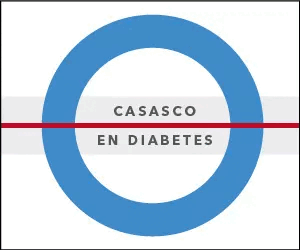Cardiovascular risk reduction strategies in people with diabetes: what have we learned?
Keywords:
diabetes, cardiovascular riskAbstract
People with diabetes have a higher risk of developing cardiovascular disease (CVD), so it is essential to implement effective strategies to reduce the risk of cardiovascular events such as heart attack, stroke, and cardiovascular death. Multifactorial and multidisciplinary management focused on the person is the key to preventing CVD. Likewise, the prevention of heart failure, kidney disease and the adequate management of adiposity are key factors, derived from the effectiveness and safety of new therapeutic strategies. The adoption of a healthy lifestyle remains the cornerstone on which any pharmacological strategy should be based. This includes a balanced and healthy diet as well as regular physical activity. The management of hypertension is crucial, using antihypertensive medications such as ACE inhibitors or ARBs. Keeping blood pressure below 140/90 mmHg is recommended, or even lower in some patients.
Lipid control is another fundamental strategy. Statins are the cornerstone of treatment to reduce LDL cholesterol and in people with high cardiovascular risk, stricter goals should be considered that can be achieved with combined therapies from the beginning of treatment (statins, ezetimibe, bempedoic acid, iPCSK9, inclisiran) to achieve an LDL below 70 mg/dL, below 55 mg/dL or even lower to minimize lipid risk (the lower the better, the sooner the better). In addition, it is important to manage other risk factors such as triglycerides and HDL cholesterol, considering that today we have strategies that have been shown to reduce the risk derived from cholesterol remnants such as the use of Eicosapent ethyl (EPA).
Finally, early use of antidiabetic medications with cardiovascular benefits, such as SGLT2 inhibitors and GLP-1 inhibitors, may provide additional protection against CVD and overall risk factor reduction since these strategies target the root causes of CVD, such as mitochondrial abnormalities, inflammation, free radical reduction, oxidative stress, atherosclerosis, albuminuria, etc. In summary, a combination of blood pressure management, adequate lipid management, adoption of a healthy lifestyle, and use of cardio-renoprotective medications are essential strategies to reduce cardiovascular risk in people with diabetes.
References
I. Dal Canto E, et al. Diabetes as a cardiovascular risk factor: An overview of global trends of macro and micro vascular complications. Eur J Prev Cardiol 2019;26(2):25-32.
II. Marso SP, et al. Semaglutide and cardiovascular outcomes in patients with type 2 diabetes. N Engl J Med 2016;375(19):1834-1844.
III. Rolek B, et al. SGLT2 Inhibitors vs. GLP-1 agonists to treat the heart, the kidneys and the brain. J Cardiovasc Dev Dis 2023;10(8):322.
Downloads
Published
How to Cite
Issue
Section
License
Copyright (c) 2024 on behalf of the authors. Reproduction rights: Argentine Society of Diabetes

This work is licensed under a Creative Commons Attribution-NonCommercial-NoDerivatives 4.0 International License.
Dirección Nacional de Derecho de Autor, Exp. N° 5.333.129. Instituto Nacional de la Propiedad Industrial, Marca «Revista de la Sociedad Argentina de Diabetes - Asociación Civil» N° de concesión 2.605.405 y N° de disposición 1.404/13.
La Revista de la SAD está licenciada bajo Licencia Creative Commons Atribución – No Comercial – Sin Obra Derivada 4.0 Internacional.
Por otra parte, la Revista SAD permite que los autores mantengan los derechos de autor sin restricciones.





































